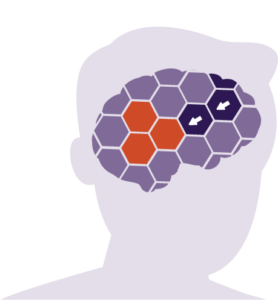How the Brain Heals after a Stroke
A stroke happens when blood fl ow to a specific area of the brain is disrupted, causing a shortage of oxygen for the brain cells in that region. These brain cells become damaged when deprived of oxygen, which can result in a loss of function in the body parts controlled by the affected area. However, the brain has a remarkable ability to recover over time through neuroplasticity, potentially recovering function in the days, weeks, and even years following a stroke.
What is neuroplasticity?
Neuroplasticity, or brain plasticity, is the brain’s ability to change and adapt.
The brain communicates through networks of neurons (brain cells) and synapses (neuron connectors). New neurons (neurogenesis) and neuron connections can be made and strengthened after a stroke.
Your brain can also be ‘rewired’ so undamaged parts can learn to take over the jobs of damaged parts (functional remodeling).
While some neuroplasticity may automatically happen after your stroke, you can potentially heal faster and recover more by doing tasks and treatments that make neuroplasticity more likely to happen. Neuroplasticity peaks during the first few months after a stroke. If you exercise your brain, recovery is possible after this time, and progress may be slower or less noticeable.
Changes in the brain happen in response to experiences or engaging in activities. You can help your brain recover by repeating meaningful activities and choosing to do activities that are not too hard or easy but “just right” in terms of difficulty level.
For example, you might lift your affected leg only using your leg muscles when placing your leg in your pants. You may also brush your hair or reach for objects with your affected arm. It can be safer to avoid handling any hot or sharp objects while your affected arm is still relearning tasks.
Enriched environments can also help the brain heal after a stroke. These include music, sunlight, mindfulness, medication, social interactions, or other elements that help awaken the senses and activate the brain.
There are some evidence-based, innovative treatments to help your brain heal after a stroke.
- Virtual Reality-based training can be a fun and engaging way to work on healing your brain using specific virtual reality environments as a tool for rehabilitation.
- Constraint-Induced Movement Therapy (CIMT) and Modified Constraint-Induced Movement Therapy. This treatment promotes using the side of the body affected by the stroke by restraining the other side. When the affected side is forced to try activities, it can improve faster. This is a potential option for people with some movement on the affected side.
- In Mirror Therapy , the person watches the unaffected part of the body move in the mirror. The brain will think that the affected side of the body is moving and will activate that part of the brain that is associated with movement on the affected side. Mirror Therapy is usually done with other traditional rehabilitation.
- Electrical Stimulation involves delivering small electrical pulses to the muscle through a small patch put directly on the muscle. This electrical pulse sends a signal and can help rebuild the connection between the muscle and brain.
- Brain-machine interfaces have the person think of moving. Then, the machine uses that brain signal to move a device. This helps the brain practice sending a signal and getting feedback from the device moving at the same time, which helps strengthen the connection and communication between the brain and body.
- Robot-assisted therapy uses a robot to help someone with movement through repetitive tasks to improve one’s ability to move on their own and be more independent.
Other rehabilitation techniques, medical treatments, and medicines continue to be researched to help the brain heal. If you are interested in these treatments, speak with your care team. Everyone is unique, and not all treatments are suitable for every person.
You may feel fatigued and need to rest during these activities and treatments. Sometimes, the recovery process can be frustrating when you can’t move or speak as you want to, so you might need to take a break or do an easier activity.
Each person’s recovery is unique. Some people may recover more, while others recover less. You can improve your chances of recovery by repetitively doing meaningful tasks and participating in rehabilitation. We encourage you to start rehabilitation early after your stroke to take advantage of neuroplasticity at its peak.






